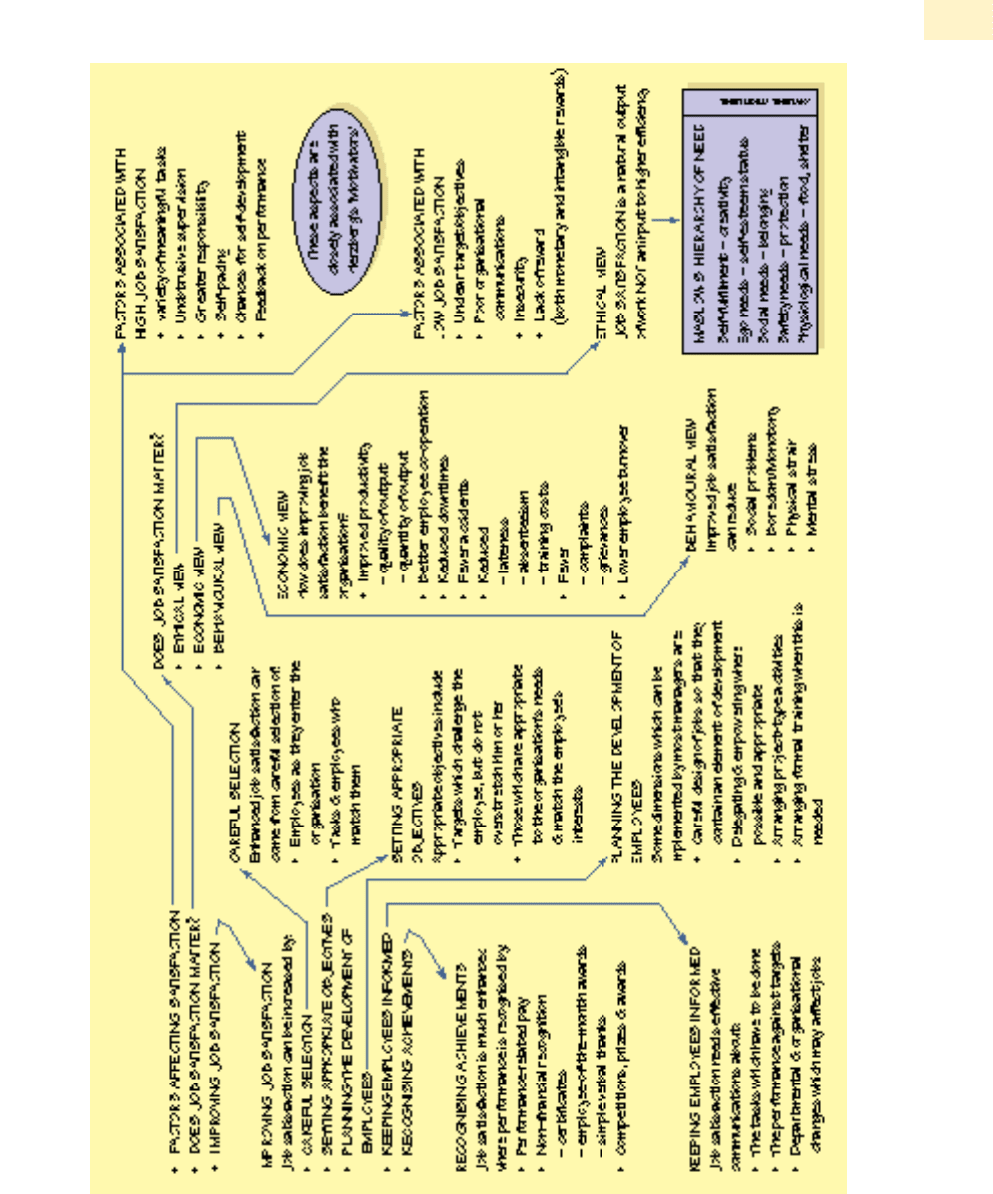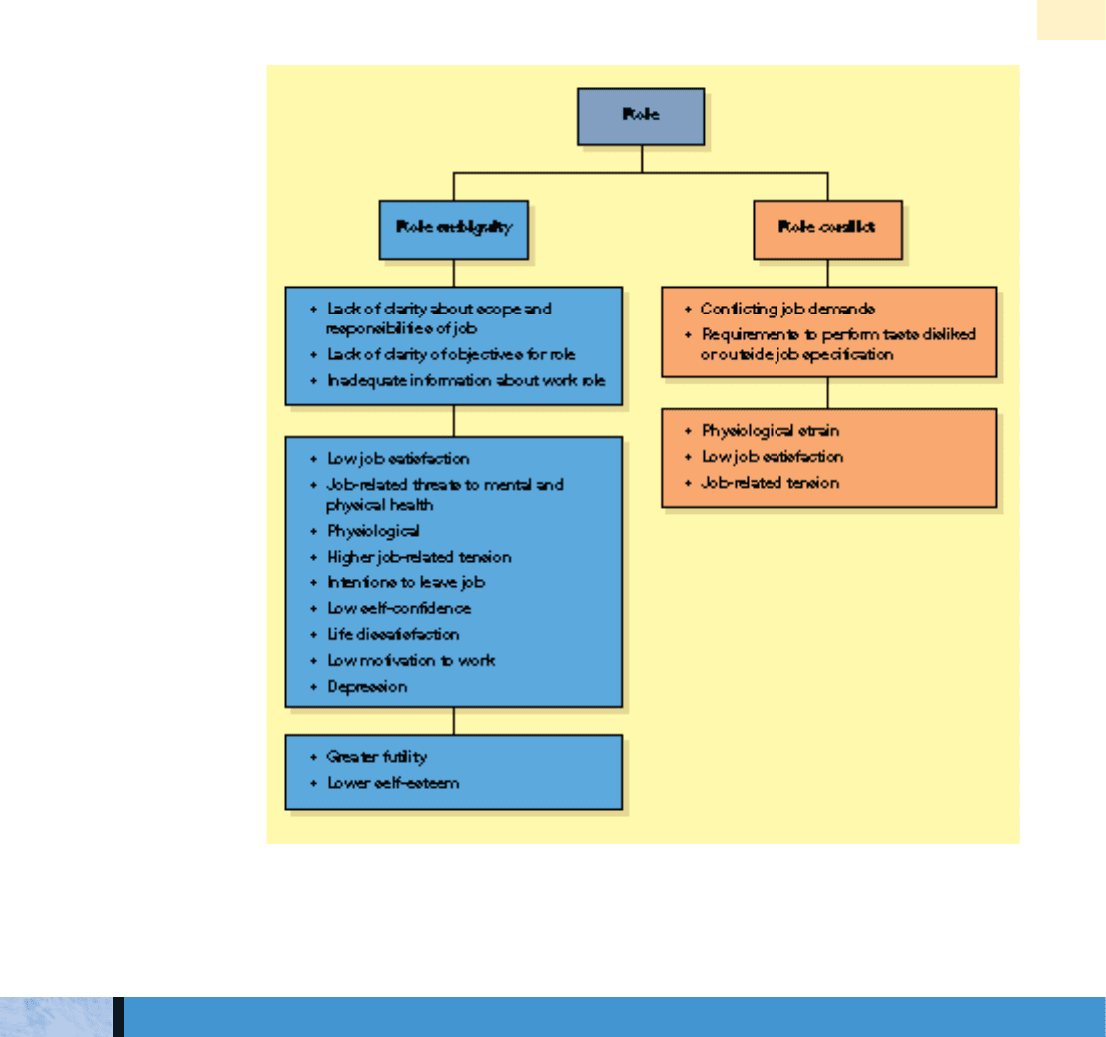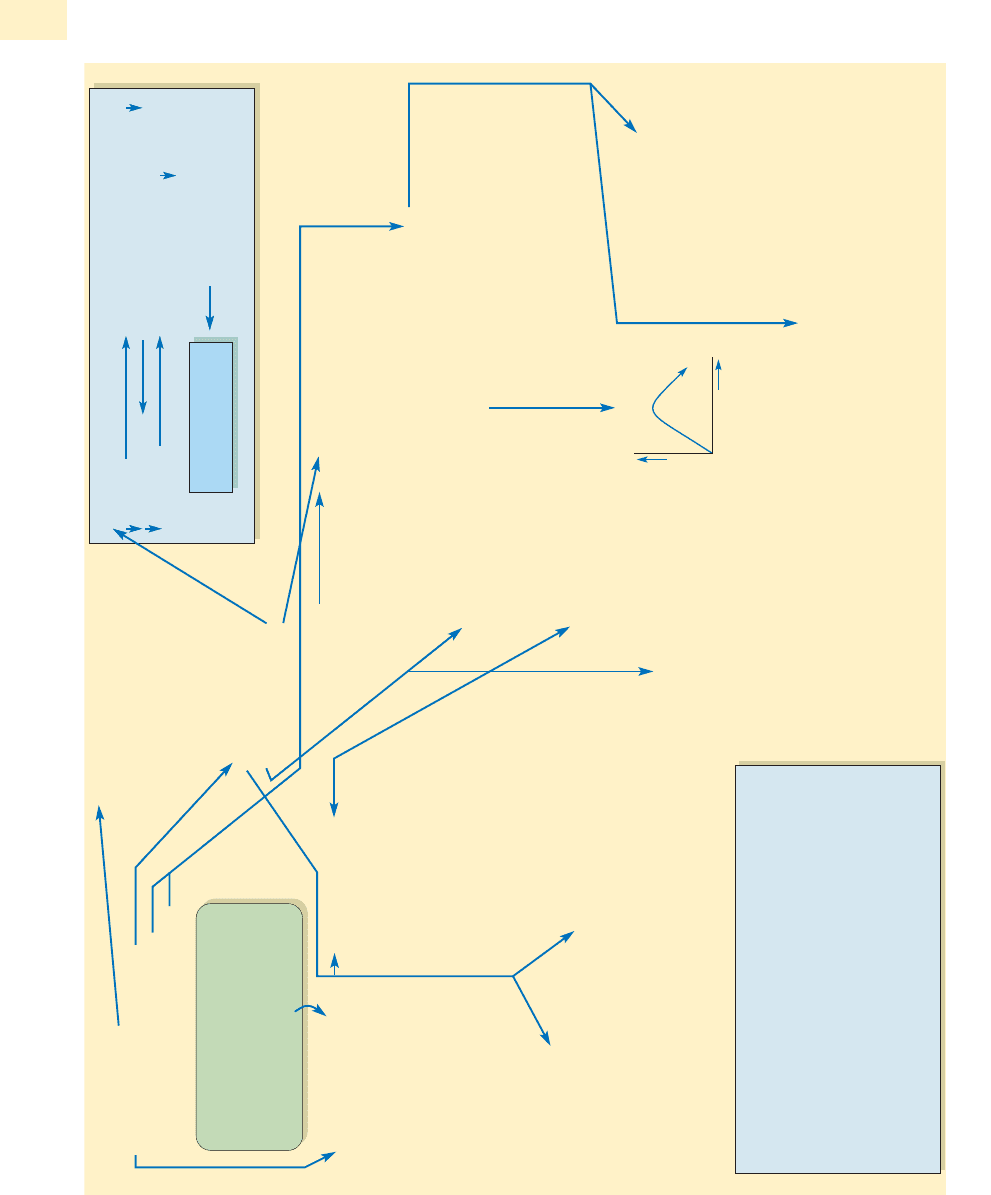Mullins L.J. Management and organisational behaviour, Seventh edition
Подождите немного. Документ загружается.


CHAPTER 18 JOB SATISFACTION AND WORK PERFORMANCE
705
Figure 18.2 Summary outline of job satisfaction
(Reproduced with permission of Training Learning Consultancy Ltd. Bristol.)

climate in which there is a greater expectation of the immediacy of receipt and
response; and adding to the dangers of information overload. For example, a report by
management company Pitney Bowes claims that the ever-increasing use of email is a
cause of rising stress levels in the workplace.
16
Potential benefits and disadvantages
The growth of information technology means that many individuals can undertake
their work at any time and anywhere, and provides for greater mobility. Lucas main-
tains that ‘the benefits to organizations, in terms of improved productivity, staff
retention and employee motivation are well documented’.
17
However, Thomas suggests
that it is impossible at this stage to draw conclusions about the impact of mobile work-
ing, which is a hugely varied experience. Whilst for some people it is good news and
may be clearly liberating, for others doing extra work and long hours of uninteresting
work is less appealing.
18
According to Law, managers of the future, especially in larger organisations, will be
someone who is a ‘personal area network’ wherever they may be, always connected to
the Internet. Managers will be using personal digital assistants (PDAs) – handheld
mobile devices that can access the Internet and act as a basic personal organiser by set-
ting up a diary. However, if too many people are working remotely too often there is a
risk of alienation and there is also the potential problem of pressures on staff who are
permanently contactable.
19
Reeves maintains that IT is potentially the most progressive
force for change in the workplace. It could free millions of workers from the drudgery
of the nine-to-five and the absurdity of presenteeism. However, far from being liberat-
ing, IT feels enslaving. Email becomes a daily tyranny, the mobile phone a corporate
electronic tagging device. Companies still expect their staff to work set hours even
when IT makes this unnecessary.
20
According to a report cited in Financial Times: ‘Stress at work is the biggest problem prob-
lem in European companies.’
21
There appears little doubt that one of the major adverse
influences on job satisfaction, work performance and productivity, and absenteeism
and turnover is the incidence of stress at work.
22
Stress is a complex and dynamic con-
cept. It is a source of tension and frustration, and can arise through a number of
interrelated influences on behaviour, including the individual, group, organisational
and environmental factors discussed in Chapter 2.
According to McKenna, for example:
In human terms any situation that is seen as burdensome, threatening, ambiguous or boring is
likely to induce stress. This is the type of situation that would normally strike the individual as
deserving immediate attention or concern and is viewed as unfortunate or annoying. There tends
to be the feeling that the situation should not exist, but because of it the person feels disap-
pointed or annoyed and eventually is prone to anxiety, depression, anger, hostility, inadequacy,
and low frustration tolerance.
23
The nature of stress
Figures from the Heath and Safety Executive (HSE) suggest that work-related stress is
the main cause of work sickness absence. ‘It’s an issue that employers are clearly going
to have to take more seriously in the future. The HSE is introducing tough new stress
standards – and organisations that don’t come up to scratch could face fines. Experts
advise that if companies want to ease the pressure, they should start by putting their
706
PART 7 MANAGEMENT OF HUMAN RESOURCES
STRESS AT WORK

working culture and management style under the microscope.’
24
There appears to be a
similar situation in the US where a survey of 333 US companies found that more work-
ers are calling in absent because of family issues, stress and personal needs.
25
Broad draws attention to the level of absenteeism in large public-sector organisations
in this country, which is nearly a third higher than staff absence in the private sector.
In the public sector, absenteeism caused by stress is preventing the delivery of quality
services. There are heavy costs associated with stress. It lowers productivity and
increases staff sickness. Pressure on the public sector to deliver is set to increase, with
the funding being tied to reform and results.
26
York contends that despite all the business-speak people get seriously vague when it
comes to definitions and raises the question: What is stress? Is it a new name for an
old-fashioned condition such as unhappiness or overwork: or is it peculiar to our
uniquely pressured times? York suggests there is something in the idea that stress isn’t
just about hard work or unhappiness, but about conflict, confusion and frustration. It’s
about the anxiety generated by multi-tasking and balancing priorities, meeting contra-
dictory demands, about knowing where to start and papering over the cracks when
you want to do too much.
27
Pressure and stress
Stress, however, is a very personal experience, as is the response of each individual to it
and their beliefs about how best to cope with the causes and effects of stress. For ex-
ample, Orpen questions the prevalent view among managers in Britain which seems to
be that stress at work is something to be avoided at all costs. Just as there are circum-
stances when individuals may have too much stress, there are also circumstances when
individuals may have too little stress for effective performance.
28
This view also appears to
be supported by Gwyther, who points out that although stress appears to have become
public health enemy number one and is viewed as the culprit of a myriad of complaints,
the term is bandied about far too readily and there is a need to stand back and attempt to
get things into some sort of perspective. A measure of stress is natural. A degree of stress at
work is no unhealthy thing and without it nothing would ever get done.
29
A certain amount of stress may arguably not necessarily be seen as a bad thing and
may even help promote a higher level of performance. But what is the distinction
between pressure and stress? ‘Pressure’ can be seen as a positive factor which may be
harnessed to help people respond to a challenge and function more effectively. On the
other hand, ‘stress’ may be regarded a continuous negative response arising from
extreme pressure or other demands and the individual’s inability to cope.
Personal performance may improve with pressure, up to a certain point. Beyond that point, con-
tinuous pressure leads to a fall in performance as the person is no longer able to cope. Signs of
this are fatigue, poor judgement and bad decision making. In turn, this can lead to serious busi-
ness problems.
30
However, it is important to bear in mind that stress can potentially be very harmful.
CHAPTER 18 JOB SATISFACTION AND WORK PERFORMANCE
707
The results of unrelieved stress on the individual and on business are worrying. The result
may be higher accident rates, sickness absence, inefficiency, damaged relationships with
clients and colleagues, high staff turnover, early retirement on medical grounds, and even
premature death … The cost of stress is huge. It is devastating to the individual and damag-
ing to the business at a time when the need to control business costs and ensure an
effective and healthy workforce is greater than ever. It is in everyone’s interest to tackle the
taboo on talking about emotional problems because it is this which inhibits individuals
from seeking help.
Simon Armson, Chief Executive, The Samaritans
31

Research into managers in various types of organisation in Western Australia showed
that delegation of responsibility to middle managers required great skill, which was too
seldom present. Replies from 532 managers in 36 organisations indicated a clear corre-
lation between lack of autonomy and stress at work. Stress was often caused by the
hierarchical structure of the organisation not permitting sufficient autonomy. As a
result, projects were frequently delayed and also managers’ authority within their own
departments was undermined.
32
The Institute of Management has undertaken research into stress management issues.
The research involved the view of nearly 1100 managers in order to explore the impact of
job-related stress among managers. A key finding was that organisational changes such as
redundancies, introduction of new technology and loss of key personnel place extra
demands on managers and increase stress. One conclusion was that the major causes of
stress in the workplace are unreasonable deadlines and office politics. Flatter manage-
ment structures do not lead to the anticipated advances in communications, efficiency,
decision-making and employee involvement. The research confirms that stress affects all
levels and types of manager. Almost 90 per cent of respondents believe that stress is
having an adverse effect on morale, health, work effectiveness and relationships.
33
One potential major source of work stress arises from role incongruence and role con-
flict (discussed in Chapter 13). Role stress can lead to difficulties in communication
and interpersonal relationships and can have an adverse affect on morale, performance
and effectiveness at work, and health. Demands for improved business competitiveness
and lower operating costs have frequently led to restructuring of organisations and
reductions in staffing levels. This has placed greater pressures on remaining staff and
resulted in a growing number of work-related health problems, work stress and a less
efficient workforce.
34
In the case of customer service, Jamison suggests that if there is a
conflict between the requirements of a customer and the requirements of the organisa-
tion this will induce unhelpful behaviour as a result of stress.
35
Handy suggests five organisational situations that are likely to create role problems
and therefore stress for the individual:
■ Responsibility for the work of others – reconciling overlapping or conflicting objec-
tives of groups and organisations, of groups and individuals, of self and superiors.
■ Innovative functions – conflicting priorities and different psychological demands
between the routine and administrative aspects of the job and the creative side.
■ Integrative or boundary functions – the particularly stressful role to the co-ordinator,
link person or outside contact, perhaps due to the lack of control over their demands
or resources.
■ Relationship problems – difficulties with a boss, subordinates or colleagues. For
some people, particularly those with a technical orientation, the need to work with
other people is a worrying complication.
■ Career uncertainty – if future career prospects become doubtful the uncertainty can
quickly become stressful and spread to affect the whole of a person’s work.
36
A summary of sources of role stress at work is given in Figure 18.3.
708
PART 7 MANAGEMENT OF HUMAN RESOURCES
Lack of
delegation and
autonomy
Are managers
under stress?
ROLE RELATIONSHIPS AND CONFLICT

An increasing number of surveys report, perceived or actual, increases in levels of
stress. There have also been a number of highly publicised reports of successful legal
claims against the effects of stress. Understandably, however, there is also a level of
scepticism about the amount of emphasis placed on stress, and a number of press and
other articles feature the ‘myth’ of work stress.
An interesting report from the Institute for Social and Economic Research suggests that
claims of workplace pressure may be misplaced. Levels of job satisfaction and mental
distress vary systematically according to the day of the week on which respondents are
CHAPTER 18 JOB SATISFACTION AND WORK PERFORMANCE
709
Figure 18.3 Source of role stress at work
(Source: Arnold, J., Cooper, C. L. and Robertson, I. T. Work Psychology: Understanding Human Behaviour in the Workplace, Third edition,
Financial Times Prentice Hall (1998) p. 434, with permission from Pearson Education Ltd.)
LEVELS OF STRESS

interviewed. Stress appears to disappear on Friday and Saturday. When genuine dissat-
isfaction was found, it tended to be because employees were working too few or too
many hours. However, the main cause of stress was money difficulties, caused by
unemployment or debt. The research casts a question mark over the generous compen-
sation regularly handed out by the courts to employees claiming they suffer from
stress.
37
Randall also makes the point that: ‘Whichever lawyer first hit on the idea of
promoting stress as either a reason for not going to work or a way to make others
cough up could hardly have done more damage to Britain’s work ethic than if he or
she had arranged a quintupling of dole payments.’
38
There are a number of measures by which individuals and organisations can attempt to
reduce the causes and effects of stress. The Health and Safety Executive (HSE) define
stress as: ‘The adverse reaction people have to excess pressure. It isn’t a disease. But if
stress is intense and goes on for some time, it can lead to a mental and physical ill
health (e.g. depression, nervous breakdown, heart disease).’
39
HSE has set out problems
that can lead to work-related stress under the headings of: culture, demands of the job,
control, relationships, change, role, support and the individual; together with what
management can do. (See Figure 18.4.) There are also many suggested techniques to
help individuals bring stress under control – for example, changing your viewpoint;
identifying causes of distress; laughing and telling jokes; working on stress reduction;
and appreciating some stress can be useful.
40
Organisations also need to give greater
attention to training, support and counselling; and to the work organisation and job
design (discussed below).
The Engineering Employers’ Federation set out a checklist of strategies relating to
building corporate awareness and managerial understanding, and avoiding and min-
imising stress by attention to:
■ job design;
■ structure of the organisation and resources;
■ management style; and
■ helping the individual to cope.
Effective management of stress can reduce absence; increase work quality and perform-
ance; reduce resistance to change; improve relationships with customers, colleagues
and suppliers; and reduce staff turnover.
41
The importance of conversations
Effective communications at all levels of the organisation are clearly important in help-
ing to reduce or overcome the level of stress. However, in addition to good
communications, Reeves also refers to the importance of conversation for maintaining
relationships and suggests a case for a conversation culture. The ability to hold good-
quality conversations is becoming a core organisational and individual skill. Unlike
communication, conversations are intrinsically creative and roam freely across per-
sonal issues, corporate gossip and work projects. ‘Conversations are a defence against
stress and other mental health problems. People with good social relationships at work
are much less likely to be stressed or anxious.’
42
A ‘summary outline’ of the meaning, causes and avoidance of stress is given in
Figure 18.5.
710
PART 7 MANAGEMENT OF HUMAN RESOURCES
COPING WITH STRESS

CHAPTER 18 JOB SATISFACTION AND WORK PERFORMANCE
711
Figure 18.4 Work-related stressors
Extract takes from INDG281Rev1. Crown Copyright 2003. Reproduced with permission of the Controller of Her Majesty’s Stationery Office.

712
PART 7 MANAGEMENT OF HUMAN RESOURCES
STRESS
• WHAT IS STRESS?
• HOW CAN STRESS BE CAUSED?
• HOW CAN YOU IDENTIFY STRESS?
• WHAT CAN YOU DO TO AVOID STRESS?
IDENTIFYING STRESS
• Unusual behaviour
• Flying off the handle more
than usual
• Tiredness
• Not getting the job done
• Nervousness
• Blaming others
• Acute stress from
major strain
• Chronic stress from
long-term strain
All managers work under pressure. When
pressure becomes too high, the manager
experiences unacceptable stress.
Organisations need to reduce stress in
managers to the level of challenge.
CONFUSED WORKING
• Conflicting priorities
• Disordered environment
– continual interruptions
• Too little feedback/Feedback
too late
• Distorted feedback/Too
much information
• Ambiguity – unclear objectives
• Too little control
UNDER-EMPLOYMENT
• Too little depending on actions
– job ignored
– job deprecated
• Stress generated by fear
– loss of job
– loss of face (to others or self)
• Under-employment from
– recruiting too high a standard
– recruiting to keep up establishment
– transfer to avoid redundancy
– overpayment preventing leaving
– cancellation of expectations
OVERWORKING
• Too great a responsibility
• Too close supervision
– too little room for manoeuvre
– negative feedback only
• Too much control
– too fast an assembly line
– poorly paced work
STRESS
• The result of a person being pushed
beyond the limit of his or her natural
capacity.
• After the cause is removed the person
does not return to his or her previous
state.
THE CAUSE OF STRESS
• WORKLOAD
• PERSONALITY
• PHYSICAL FACTORS
OLD AGE
• problems from paced work
• problems from poor feedback
• fear of under-employment
– redundancy
– deprecation
DRIVING
• always trying to get things done
• generally
– poor team member
– doesn’t suffer fools
– prefers short-term problems
• stress from UNDER-EMPLOYMENT
INTERNAL RESPONSE TO STRESS
• if things go wrong they take
it out on themselves
– generally introvert
– withdrawing
– careful
– stress from OVERWORKING
EXTERNAL RESPONSE TO STRESS
• If things go wrong he or she
takes it out on other people.
• Generally
– extrovert
– status conscious
– decisive decision-taker
– stress from confused working.
PHYSICAL STRESS
• low physical fitness
• increases vulnerability to stress
• large frequent meals reduce fitness
• smoking
• drinking
• little sleep
• little exercise
TYPES OF STRESS
Acute – Short term can be caused by
• Sharp increase/decrease in orders
• Key staff leaving/sickness in others
• Industrial disputes/strikes
Chronic – Long term caused by
• Lack of clarity of organisational goals
• Protracted takeover negotiations
• Promotion above manager’s level of
competence
• Non-supportive organisational
systems
AVOIDING STRESS (Acute stress)
• Decide if you are doing the right job.
• If under threat take deeper breaths
– pace the interview
– answer one question at a time
– answer questions with questions
– keep calm, watch how you appear
to others.
AVOIDING STRESS (Chronic stress)
• Keep fit & sleep enough.
• Plan relations & limit work time.
• Don’t get worked up at work.
• Decide if you are doing the right job.
– What do you want from life?
– Death is nature’s way of telling
you to slow down!
Pe r formance
Drive
(motivation & movement)
PERSONAL CRISES OUTSIDE WORK
Promotion Increase in discretionary part of the job.
Increased workload No one with whom to discuss difficulties.
Working late Work becomes an obsession.
Exhaustion and anxiety
Stress-related absence –
loses more days per year
than industrial action
Off work for a long spell
with acute depression
ORGANISATIONAL STRATEGIES FOR REDUCING STRESS
TRAINING
• Induction
• Specific training
• Time planning
• Assertiveness
• Stress awareness
EXAMINE REWARD
SYSTEMS
• Pay
• Other benefits
• Intangible rewards
REVIEW ORGANISATIONAL
AIMS, OBJECTIVES &
SYSTEMS
• Needs & objectives change
with time
• Systems need to reflect
these changes
EMPLOYING CHANGE
CONSULTANTS
• When major change is
contemplated
RELAXATION TECHNIQUES
Consider new techniques,
diet analysis, counselling
& advice systems. Organisation
can support through:
– relaxation – Alexander technique/
Yoga/Circle dancing/Sports/
Cultural activities
EMPLOYEE APPRAISAL
• Target setting
• Controlling expectations
Figure 18.5 Summary outline of stress
(Reproduced with permission of Training Learning Consultancy Ltd, Bristol.)

No easy remedies
However, there are not always easy remedies for stress and much depends upon the
personality of the individual. Techniques such as relaxation therapy may help some
people, although not others, but still tend to address the symptoms rather than the
cause. For example, as Vine and Williamson point out, stress-inducing hazards are hard
to pin down, much less eliminate. It is important to know how people feel about the
things which cause them stress as well as which ‘stressors’ are most common in a par-
ticular industry and occupation. Human resource policy should include several stress
management building blocks within the organisation structure including management
education, employee education, counselling and support, critical incident briefing, and
good sound management.
43
A study by van ZylKobus Lazenby found that South African managers in affirmative
action positions are functioning in a stressful environment which can give rise to
unethical acts. Results indicated that high stress correlates substantially with: claiming
credit for a subordinate’s work; failing to report a co-worker’s violation of company
policy; offering potential clients fully paid holidays; and purchasing shares upon hear-
ing privileged company information.
44
Hayes and Hudson advance an argument that stress has been divorced from the working
environment in which it develops and become an autonomous beast – a beast that can
be tamed by counselling rather than by more pay and a shorter working day or by clear
job control and security. The phenomenon of stress is on the one hand an individualis-
tic response to the traditional experience of work in more onerous times. This is an
element of continuity. This accounts for the response to the TUC ‘bad boss’ hotline set
up in December 1997. The TUC reported 2400 calls in the first two days. On the other
hand stress is also the phenomenon of a newer more responsible and deferential
worker who has internalised the needs of the company but is not sure whether he or
she has done so correctly and in the right degree. This is an element of change in
workplace relations which even though it is more individualised is the contemporary
form of social mediation.
Far from being a positive development this is harmful for two reasons. The first reason
is that for the individual who appeals to ‘stress’ as a pragmatic palliative the outlook
encourages a sense of victimhood rather than one of problem-solving. The second reason
is that the new relationship between employer and employee very often represents a
form of regulation in workplace behaviour which is highly intrusive. The very concept of
stress becomes an instrument of self-regulation. Stress is not resolved by higher pay,
reduced hours or a better working environment, which have a collective aspect to them,
but by a trip to the counsellor in which the individualised experience of the workplace is
reinforced. The employee is at risk not from exploitation or intensification but from fail-
ure to adjust to a new working environment. The employee can be protected not
through collective action but through a series of regulations and codes of behaviour. If
this is the case there then exists an attempt to solve the perceived problem of an absence
of social links and networks through the codification of atomisation.
45
An account of the elusive but expensive concept of stress is given in
Management in Action 18.2.
The application of motivational theories, and greater understanding of dimensions of
job satisfaction and work performance, have led to increasing interest in job design.
The nature of the work organisation and the design of jobs can have a significant effect
CHAPTER 18 JOB SATISFACTION AND WORK PERFORMANCE
713
Stress and
counselling
WORK ORGANISATION AND JOB DESIGN

on the job satisfaction of staff and on the level of organisational performance. Job
design is associated with the ideas of the neo-human relations approach (discussed in
Chapter 3) and the work of writers such as Herzberg. According to Burns: ‘Job Design is
a direct attack on the precepts of the Classical approach. Whereas Taylorist tradition
seeks to fit people to rigidly defined and controlled jobs, Job Design theorists argue
that jobs can and should be fitted to human needs.’
46
Job design is concerned with the relationship between workers and the nature
and content of jobs, and their task functions. It attempts to meet people’s personal
and social needs at work through reorganisation or restructuring of work. There are
two major reasons for attention to job design:
■ to enhance the personal satisfaction that people derive from their work; and
■ to make the best use of people as a valuable resource of the organisation and to help
overcome obstacles to their effective performance.
Earlier approaches to job design concentrated on the restructuring of individual jobs
and the application of three main methods: (i) job rotation; (ii) job enlargement; and
(iii) job enrichment.
■ Job rotation is the most basic form of individual job redesign. Job rotation involves
moving a person from one job or task to another. It attempts to add some variety
and to help remove boredom, at least in the short term. However, if the tasks
involved are all very similar and routine, then once the person is familiar with the
new task the work may quickly prove boring again. Job rotation may lead to the
acquisition of additional skills but does not necessarily develop the level of skills.
Strictly, job rotation is not really job design because neither the nature of the task
nor the method of working is restructured. However, job rotation may help the
person identify more with the completed product or service. It can also be used as a
form of training and a means of establishing connections.
■ Job enlargement involves increasing the scope of the job and the range of tasks that
the person carries out. It is usually achieved by combining a number of related
operations at the same level. Job enlargement is horizontal job design; it makes
a job structurally bigger. It lengthens the time cycle of operations and may give
the person greater variety. Job enlargement, however, is not always very popular
and may often be resisted by workers. Although it may give the person more to do,
it does little to improve intrinsic satisfaction or a sense of achievement. Workers
may see job enlargement as simply increasing the number of routine, boring tasks
they have to perform. Some workers seem to prefer simple, routine tasks which
they can undertake almost automatically, and with little thought or concentration.
This enables them to day-dream and to socialise with colleagues without affecting
their performance.
■ Job enrichment is an extension of the more basic job rotation and job enlargement
methods of job design. Job enrichment arose out of Herzberg’s two-factor theory. It
attempts to enrich the job by incorporating motivating or growth factors such as
increased responsibility and involvement, opportunities for advancement and the
sense of achievement. Job enrichment involves vertical job enlargement. It aims
to give the person greater autonomy and authority over the planning, execution
and control of their own work. It focuses attention on intrinsic satisfaction. Job
enrichment increases the complexity of the work and should provide the person
with a more meaningful and challenging job. It provides greater opportunities for
psychological growth.
714
PART 7 MANAGEMENT OF HUMAN RESOURCES
INDIVIDUAL JOB REDESIGN
